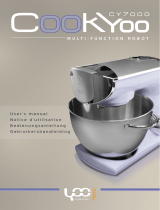
the mixing tools and some of their uses
K beater
l
For making cakes, biscuits, pastry, icing, fillings, éclairs and
mashed potato.
whisk
l
For eggs, cream, batters, fatless sponges, meringues,
cheesecakes, mousses, soufflés. Don’t use the whisk for heavy
mixtures (eg creaming fat and sugar) – you could damage it.
dough hook
l
For yeast mixtures.
to use your mixer
1 Lift the head release lever at the back of the appliance
and at the same time lift the head until it locks in the raised
position .
to insert a tool 2 Push up until it stops then turn .
3 Fit the bowl onto the base. Place the handle directly over the
unlock symbol , then gently turn the bowl clockwise until the
handle is directly above the lock symbol . DO NOT USE
excessive force and DO NOT overtighten .
4 Lift the head release lever at the back of the appliance and at the
same time lower the mixer head .
5 Plug into the power supply and the mixer ready indicator light
will glow.
6 Switch on by turning the speed switch to the desired setting.
to remove a tool 7 Turn and remove.
important
l
If the mixer head is raised during operation, the machine will stop
working straight away. To re-start the mixer, lower the mixer head,
turn the speed switch to the off position, wait a few seconds and
then re-select the speed. The mixer should resume operating
straight away.
l
Whenever the mixer head is raised the mixer ready indicator light
will go out. When the head is lowered, the light will glow indicating
the mixer is ready to use.
hints
l
The fold function can be used for folding light ingredients into
heavier mixtures for example meringues, mousses, fruit fools,
Genoese sponges and souffles, and to slowly incorporate flour and
fruit into cake mixtures. The mixer will operate at a constant slow
speed.
l
Eggs at room temperature are best for whisking.
l
Before whisking egg whites, make sure there’s no grease or egg
yolk on the whisk or bowl.
l
Use cold ingredients for pastry unless your recipe states otherwise.
l
When creaming fat and sugar for cake mixes, always use the
fat at room temperature or soften it first.
5
the mixer











